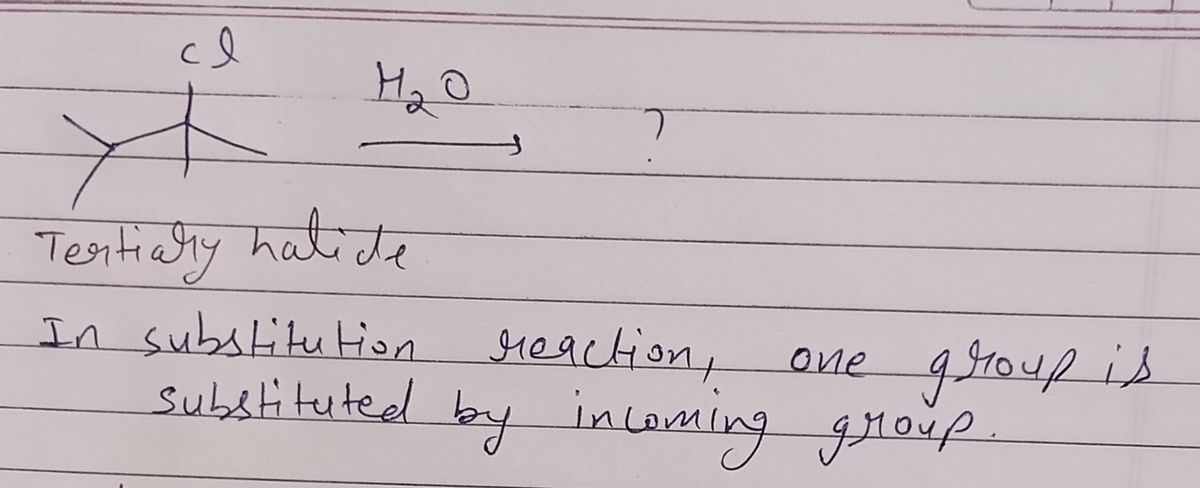Chemistry
10th Edition
ISBN:9781305957404
Author:Steven S. Zumdahl, Susan A. Zumdahl, Donald J. DeCoste
Publisher:Steven S. Zumdahl, Susan A. Zumdahl, Donald J. DeCoste
Chapter1: Chemical Foundations
Section: Chapter Questions
Problem 1RQ: Define and explain the differences between the following terms. a. law and theory b. theory and...
Related questions
Question

Transcribed Image Text:**Title: Understanding Major Substitution Products in Chemical Reactions**
**Question:**
What is the major substitution product of the following reaction?
**Reaction Diagram:**
1. **Reactant:**
- The chemical structure shown has a chlorine (Cl) atom attached to a carbon. This carbon is part of a branching hydrocarbon chain.
2. **Reagent:**
- \( \text{H}_2\text{O} \) (Water)
3. **Arrow indicating chemical reaction.**
**Answer Choices:**
**Option 1:**
- A branched hydrocarbon structure with an \( \text{OH}_2 \) group attached to the carbon where the chlorine was initially located.
**Option 2:**
- A branched hydrocarbon structure showing both \(\text{HO}\) and \(\text{Cl}\) groups attached to the carbon where the chlorine was initially located.
**Option 3:**
- A branched hydrocarbon structure with an \( \text{OH} \) group replacing the chlorine atom on the original carbon atom.
**Explanation:**
In this problem, you are tasked with identifying the major substitution product when the reactant undergoes a chemical reaction with water. Each option represents a potential product formed through nucleophilic substitution, where chlorine could potentially be replaced by a hydroxyl group (OH).
**Note:**
It’s essential to consider the reactivity and stability of intermediates in predicting major products in such reactions.
Expert Solution
Step 1

Step by step
Solved in 2 steps with 2 images

Recommended textbooks for you

Chemistry
Chemistry
ISBN:
9781305957404
Author:
Steven S. Zumdahl, Susan A. Zumdahl, Donald J. DeCoste
Publisher:
Cengage Learning

Chemistry
Chemistry
ISBN:
9781259911156
Author:
Raymond Chang Dr., Jason Overby Professor
Publisher:
McGraw-Hill Education

Principles of Instrumental Analysis
Chemistry
ISBN:
9781305577213
Author:
Douglas A. Skoog, F. James Holler, Stanley R. Crouch
Publisher:
Cengage Learning

Chemistry
Chemistry
ISBN:
9781305957404
Author:
Steven S. Zumdahl, Susan A. Zumdahl, Donald J. DeCoste
Publisher:
Cengage Learning

Chemistry
Chemistry
ISBN:
9781259911156
Author:
Raymond Chang Dr., Jason Overby Professor
Publisher:
McGraw-Hill Education

Principles of Instrumental Analysis
Chemistry
ISBN:
9781305577213
Author:
Douglas A. Skoog, F. James Holler, Stanley R. Crouch
Publisher:
Cengage Learning

Organic Chemistry
Chemistry
ISBN:
9780078021558
Author:
Janice Gorzynski Smith Dr.
Publisher:
McGraw-Hill Education

Chemistry: Principles and Reactions
Chemistry
ISBN:
9781305079373
Author:
William L. Masterton, Cecile N. Hurley
Publisher:
Cengage Learning

Elementary Principles of Chemical Processes, Bind…
Chemistry
ISBN:
9781118431221
Author:
Richard M. Felder, Ronald W. Rousseau, Lisa G. Bullard
Publisher:
WILEY